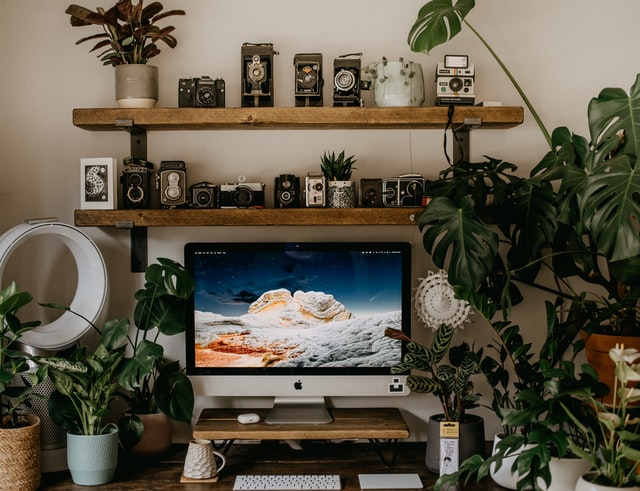Today, more people than ever are working from home. Your own home office may have seen an uptick in traffic and overall use, and it could be serving as a workspace for more than one person. You may share it with a roommate or significant other. Children may be taking online classes there, or at the very least hanging out and doing their homework. If you’re lucky, you could have it all to yourself and be able to set it up the way you prefer to maximize productivity. This week, we’re teaming up with Ray Ko from shopPOPdisplays to bring you some ideas and helpful tips about finding a work/life balance when work and life happen in the same place.
Quick-Grab Office Supplies Organizer on the Desk
While work largely lives on the computer screen in a home office, there are still those moments where you need to jot down a note. You may often need paper, pens or pencils, Post-It notes, a notebook, etc. Your work may involve a ruler, paperclips, a handheld hole puncher, scissors, or some other tool from time to time. Find an organizer that can house all these items and keep them within reach. Even if you don’t use these tools every day, you avoid time wasted hunting them down when they’re needed.
Home Office Printer Station (a Mobile One is Even Better)
Printers make for great gathering areas in a workplace. The same might be true in your home. Think about where your printing station should be located. If you print a lot, you might want it within reach of your desk, but consider whether others in your home print from laptops in other rooms. In that case, a more central place might be better to avoid heavy traffic in your office. Don’t rule out using a mobile media cart that can serve as a place to store paper and others supplies, in addition to the printer. With wheels, you can move it whenever and wherever needed.
Cord Organizer for Home Offices
If you’re setting up an office or reorganizing it, think about where cords will be stored. It’s easy to think they will all run along the walls behind large pieces of furniture, but consider desks with cord storage built-in. If you’re on a budget, some DIY hacks use screws, hooks, and a wire or acrylic basket to create storage compartments under a desk. Cord organization isn’t just about the desk, but think practically about how to keep cords out of your way for aesthetics and safety.
The Right Type of Bookshelves for Your Home Office
It’s easy to settle for what the office furniture store has to offer when it comes to bookshelves, but take an inventory of the books you already have and assess whether you’ll be adding to or reducing your collection before you spring for any.
Don’t buy more space than you need. An underutilized, bulky shelving unit may end up capturing files, supplies, and other stuff, too. Some extra items can make these setups look neat and functional, others not so much. Either way, you don’t want your shelves to become a dumping ground. Don’t rule out floating or other hanging shelf options, either. If you don’t have many books and they are more of a decorative item, individual shelves offer a pleasant aesthetic.
A Place for Files
The world has become increasingly paperless, but there are situations when you still need a hard copy of something. Designate a filing space for necessary paper documents. As well, sometimes our eyes just get tired of looking at virtual files on screens. You may find it refreshing to have printed copies to work with. You needn’t have an entire filing cabinet at the ready. A desktop organizer will do for those with just a few files.
A Home Office Mail Catch
Mail piles can contribute to stress and a chaotic look in an office. Designate a basket or bin as a place to drop your mail. If you don’t have time to go through it immediately, schedule one or two times per week to do it. It can be on a break from work or a time when you need to mentally separate from your work. When you go through the mail, set a goal to empty the basket completely each time. You can also have a bin or rack for files that need to be put away in your filing cabinet. Make sure these spaces are emptied regularly as well.
Color Coding and Labels
It’s not a good idea to have a space where only you know where everything is. Get into the habit of color-coding files and creating labels that are easy to understand for you and others who use your space. You can designate specific colors for types of files, too, such as “finances,” “medical,” “home” and other categories. Just as you have to think of who will use the printer, remember those moments when others need to enter your office space to find something. Make it easy. They’ll appreciate it.
A Final Thought on Home Office Organization
Regardless of whether you’re setting up a new home office, reorganizing one, or simply doing a quick refresh or cleanup, it’s important to enjoy the effort. Sometimes, a few small changes can make a space a little more functional or fuel some inspiration. If you think you don’t have the room to work, consider putting what you can in a storage unit. A clean slate will let you be creative, have fun and enjoy the time you put into organizing your home office.

Ray Ko has been creating effective visual merchandising and interior design strategies for retailers for more than 20 years. Today, he is the senior e-commerce manager for shopPOPdisplays, a leading designer and manufacturer of stock and custom acrylic product.


